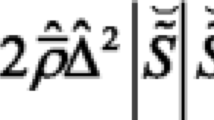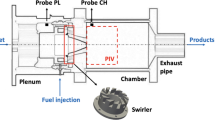Abstract
This work presents an experimental and numerical investigation of premixed flame propagation in a hydrogen/air mixture in a closed combustion vessel. In the experiment, high-speed schlieren video photography and pressure sensor are used to examine the flame dynamics and pressure transient. In the numerical study, a large eddy simulation (LES) based on a RNG sub-grid approach and a LES combustion model is applied to reproduce experimental observations. The effects of four physical phenomena on the burning velocity are considered in the combustion model, and the impact of grid type on the combustion dynamics is examined in the LES calculations. The flame experiences four stages both in experiment and LES calculations with structured and unstructured grids, i.e., spherical flame, finger-shaped flame, flame with its skirt in contact with the sidewalls, and tulip-shaped flame. The flame speed and pressure in the vessel develop with periodical oscillations in both the experiment and LES simulations due to the interaction of flame front with pressure wave. The numerical simulations compare well with the detailed experimental measurements, especially in term of the flame shape and position, pressure build-up, and periodical oscillation behaviors. The LES combustion model is successfully validated against the bench-scale experiment. It is put into evidence that mesh type has an impact to a certain extent on the numerical combustion dynamics, and the LES calculation on structured grid can predict the flame dynamics and pressure rise more accurately than that on unstructured grid with the same mesh resolution. The flame shape is more asymmetrical in the LES on an unstructured grid than that on a structured grid, and both the flame speed and the pressure rise at the later flame stage are underestimated in the LES on the unstructured grid.







Similar content being viewed by others
References
Verhelst S, Wallner T (2009) Hydrogen-fueled internal combustion engines. Prog Energy Combust 35:490–527
Bychkov VV, Liberman MA (2000) Dynamics and stability of premixed flames. Phys Rep 325:116–237
Law CK (2007) Combustion at a crossroads: status and prospects. Proc Combust Inst 31:1–29
Dorofeev SB (2011) Flame acceleration and explosion safety applications. Proc Combust Inst 33:2161–2175
Molkov V, Verbecke F, Makarov D (2008) Les of hydrogen-air deflagrations in a 78.5-m tunnel. Combust Sci Technol 180:796–808
Zhang YJ, Huang ZH, Wei LJ et al (2011) Experimental and kinetic study on ignition delay times of methane/hydrogen/oxygen/nitrogen mixtures by shock tube. Chin Sci Bull 56:2853–2861
Zhao ZL, Chen Z, Chen SY (2011) Correlations for the ignition delay times of hydrogen/air mixtures. Chin Sci Bull 56:215–221
Bychkov V, Akkerman V, Fru G et al (2007) Flame acceleration in the early stages of burning in tubes. Combust Flame 150:263–276
Dunn-Rankin D, Sawyer RF (1998) Tulip flames: changes in shape of premixed flames propagating in closed tubes. Exp Fluids 24:130–140
Matalon M, Metzener P (1997) The propagation of premixed flames in closed tubes. J Fluid Mech 336:331–350
Valiev DM, Akkerman V, Kuznetsov M et al (2013) Influence of gas compression on flame acceleration in the early stage of burning in tubes. Combust Flame 160:97–111
Metzener P, Matalon M (2001) Premixed flames in closed cylindrical tubes. Combust Theory Model 5:463–483
Xiao HH, Wang QS, He XC et al (2011) Experimental study on the behaviors and shape changes of premixed hydrogen-air flames propagating in horizontal duct. Int J Hydrogen Energy 36:6325–6336
Akkerman VB, Bychkov VV, Bastiaans RJM et al (2008) Flow-flame interaction in a closed chamber. Phys Fluids 20:055107
Chen XF, Sun JH, Liu Y et al (2007) Microstructure of premixed propane/air flame in the transition from laminar to turbulent combustion. Chin Sci Bull 52:685–691
Clanet C, Searby G (1996) On the ‘‘tulip flame’’ phenomenon. Combust Flame 105:225–238
Marra FS, Continillo G (1996) Numerical study of premixed laminar flame propagation in a closed tube with a full Navier–Stokes approach. Proc Combust Inst 26:907–913
Nkonga B, Fernandez G, Guillard H et al (1993) Numerical investigations of the tulip flame instability—comparisons with experimental results. Combust Sci Technol 87:69–89
Xiao HH, Wang QS, He XC et al (2010) Experimental and numerical study on premixed hydrogen/air flame propagation in a horizontal rectangular closed duct. Int J Hydrogen Energy 35:1367–1376
Dunn-Rankin D, Barr PK, Sawyer RF (1986) Numerical and experimental study of “Tulip” flame formation in a closed vessel. Proc Combust Inst 21:1291–1301
Matalon M, Mcgreevy JL (1994) The initial development of a tulip flame. Proc Combust Inst 25:1407–1413
Starke R, Roth P (1986) An experimental investigation of flame behavior during cylindrical vessel explosions. Combust Flame 66:249–259
Kratzel T, Pantow E, Fischer M (1998) On the transition from a highly turbulent curved flame into a tulip flame. Int J Hydrogen Energy 23:45–51
Chen XF, Sun JH, Yao LY (2008) Characteristics of fine structure during tulip flame forming. J Combust Sci Technol 14:350–354 (in Chinese)
Molkov V, Makarov D, Grigorash A (2004) Cellular structure of explosion flames: modeling and large-eddy simulation. Combust Sci Technol 176:851–865
Molkov V, Makarov D, Schneider H (2006) Les modelling of an unconfined large-scale hydrogen-air deflagration. J Phys D Appl Phys 39:4366–4376
Yakhot V, Orszag SA (1986) Renormalization-group analysis of turbulence. Phys Rev Lett 57:1722–1724
Molkov V (2009) A multiphenomena turbulent burning velocity model for large eddy simulation of premixed combustion. In: Roy GD (ed) Nonequilibrium phenomena: plasma, combustion, atmosphere. Torus, Moscow, pp 315–323
Molkov V, Makarov D, Puttock J (2006) The nature and large eddy simulation of coherent deflagrations in a vented enclosure-atmosphere system. J Loss Prev Process 19:121–129
Molkov VV, Nekrasov VP (1981) Normal propagation velocity of acetone-air flames versus pressure and temperature. Combust Explo Shock Waves 17:280–283
Lamoureux N, Djebaili-Chaumeix N, Paillard CE (2003) Laminar flame velocity determination for h-2-air-he-co2 mixtures using the spherical bomb method. Exp Therm Fluid Sci 27:385–393
Zimont VL, Lipatnikov AN (1995) A numerical model of premixed turbulent combustion of gases. Chem Phys Rep 14:993–1025
Molkov VV, Nekrasov VP, Baratov AN et al (1984) Turbulent gas combustion in a vented vessel. Combust Explo Shock Waves 20:149–153
Yakhot V (1988) Propagation velocity of premixed turbulent flames. Combust Sci Technol 60:191–214
Matalon M (2009) Flame dynamics. Proc Combust Inst 32:57–82
Oran ES, Boris JP (2000) Numerical simulation of reactive flow. Cambridge University Press, Cambridge
Gonzalez M (1996) Acoustic instability of a premixed flame propagating in a tube. Combust Flame 107:245–259
Gnoffo PA, White JA (2004) Computational aerothermodynamic simulation issues on unstructured grids. AIAA-2004-2371
Togashi F, Löhner R, Tsuboi N (2009) Numerical simulation of H2/air detonation using unstructured mesh. Shock Waves 19:151–162
Acknowledgments
This work was financially supported by the National Natural Science Foundation of China (51376174), the Chinese Postdoctoral International Exchange Program (2013), and the National Basic Research Program of China (2012CB719702).
Author information
Authors and Affiliations
Corresponding author
About this article
Cite this article
Xiao, H., Mao, Z., An, W. et al. Experimental and LES investigation of flame propagation in a hydrogen/air mixture in a combustion vessel. Chin. Sci. Bull. 59, 2496–2504 (2014). https://doi.org/10.1007/s11434-014-0281-y
Received:
Accepted:
Published:
Issue Date:
DOI: https://doi.org/10.1007/s11434-014-0281-y




